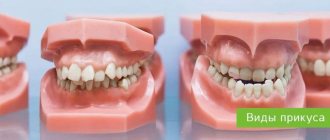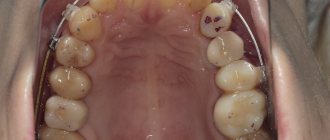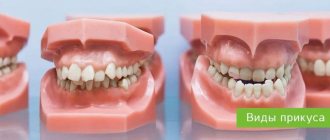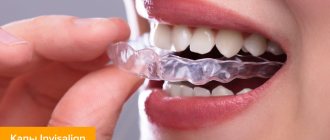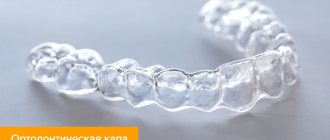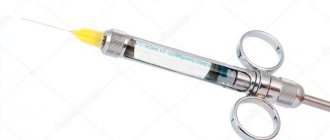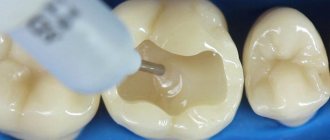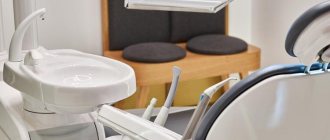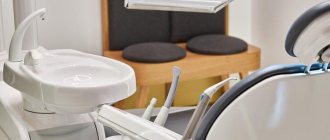How a bite is formed What a correct bite looks like Types Definition of a bite Possible consequences Methods of correction
Teeth bite is the relative arrangement of the dentition when the jaws are completely closed.
The formation of the dental system begins in intrauterine development. By the 11th week, the fetus has jaw stripes. Almost all children are born with malocclusion. The lower jaw is moved back. Dentists call this phenomenon retrognathia. When a baby actively sucks, the muscles are trained. By 6-8 months with breastfeeding, and a little later, with artificial feeding, the lower jaw takes the correct position. For bottle-fed children, it is necessary to monitor the position of the body and the hole in the nipple. If the formula does not flow from the bottle, you have to make an effort to get it, the child’s tongue and jaw muscles receive sufficient stress and malocclusions can be avoided.
Check your bite
There are a number of objective parameters by which the correct, or in other words physiological, bite is determined:
- When closing, the teeth of the upper jaw come into contact with the lower teeth of the same name. The ideal arrangement of teeth is one in which the upper incisors overlap the lower ones by 1/3.
- clear contact of the chewing teeth: molars and premolars,
- no interdental spaces,
- the vertical axis of symmetry of the face passes exactly between the central incisors,
- no problems with diction, chewing and swallowing.
All types of occlusion in dentistry are divided into abnormal and physiological, and within these groups there is a more detailed classification.
Types of correct bite
Let's consider the physiological types of occlusion and their features:
- orthognathic bite - an ideal in which the same 1/3 overlap is observed, which was mentioned above;
- straight - there is no overlap, as in the previous version: the upper and lower incisors are in contact with the cutting edges. This increases the risk of tooth wear, but from the point of view of orthodontics, this case refers to the types of correct bite;
- biprognathic - all incisors are slightly inclined towards the lips, the dentition is pushed forward, but there are no occlusion disorders;
- progenic – the lower jaw is slightly protruded. The closure is tight.
These types of dentition bites do not affect either aesthetics or functionality and are therefore considered the norm.
Prevention
Orthodontic correction of any malocclusion is a rather complex and lengthy process. As a result, preventive measures should not be neglected.
In this case we are talking about children, for which there is a completely logical explanation. Only during the periods of teeth formation can one influence the fact that negative consequences in the form of the formation of malocclusion and associated difficulties do not arise in principle. If we talk about adults, then in one hundred percent of cases the help of a qualified specialist is required.
So, what exactly measures can save a child from the likelihood of malocclusion? There are several of these:
- healthy and balanced nutrition for the mother during pregnancy (the daily diet should, in particular, include foods rich in calcium and fluorine),
- careful monitoring of the child’s nutrition from the moment of birth until approximately 14 years of age, when baby teeth are completely replaced by molars;
- monitoring correct breathing (the baby should breathe only through the nose);
- weaning a child from the bad habit of sucking various objects (accustoming to a pacifier is also not recommended);
- Regular visits to the pediatric dentist.
It is worth noting that all of the above measures allow you to achieve the desired result, provided there is no genetic predisposition.
However, the best news here is this: thanks to advanced technologies, today it is possible to cure all of the above pathologies. Bite correction in Voronezh from the dentists of the “Your Health” clinic is guaranteed effectiveness and safety for any occlusion anomalies. Moreover, the sooner such treatment and preventive measures begin, the faster a successful result will be obtained.
Incorrect or abnormal bite
The bite is considered incorrect when there are anomalies in the location of the teeth and occlusion disorders, as a result of which the functions of the dentofacial system are disrupted. All types of malocclusion, to a greater or lesser extent, lead to the destruction and loss of teeth, disorders of the TMJ (temporomandibular joint), as well as facial asymmetry. The consequences of an abnormal bite are discussed in more detail below. Orthodontic treatment in this case is necessary not so much for aesthetics, but for maintaining health.
Causes of pathologies
An abnormal bite can either be the result of a genetic predisposition (i.e., inherited), or acquired as a result of various diseases, as well as other factors. The first reason is the most common.
If we talk about acquired factors, then the top three are as follows:
- improper child care during breastfeeding,
- poor posture in preschool and early school age,
- frequent diseases of the nasopharynx with respiratory rhythm disturbances.
In fact, the full list of such root causes is much wider, since it includes all sorts of particular conditions. Moreover, their influence is also quite significant.
Types of malocclusion
The following types of malocclusion in adults are distinguished:
- distal bite
– the upper jaw protrudes forward. The upper incisors can be inclined forward, towards the lips, or backward, into the oral cavity. Often there is no contact between the front teeth of the upper and lower jaws, a sagittal gap and disocclusion (lack of closure) are formed. This type of dental malocclusion is visually manifested in a beveled profile and an upper lip hanging over the lower lip; a “double chin” may form;
- mesial bite
– the lower jaw protrudes forward. Here, a sagittal gap may also be observed and there may be no occlusion, or there may be only a slight overlap of the upper teeth with the lower ones. External signs of mesial occlusion are a protruding lower jaw and a massive chin; the lower lip is usually enlarged;
- deep bite
– the lower incisors are hidden by the upper ones by 50% or more. Depending on the stage, with a deep bite in adults, occlusion may be completely absent and inflammation of the tissues of the upper palate may develop due to injury to the lower teeth. With a deep bite, the so-called gummy smile is common, the lower third of the face looks inharmoniously small, and the chin is sloping;
- open bite
– when the jaws close, there is no contact between the upper and lower teeth. This type of bite causes significant impairment of chewing and speech functions; the facial muscles are usually overstrained and the lower part of the face is elongated;
- crossbite
– vertical asymmetry of the jaws; When closing, an intersection of the dentition is observed. It develops when one of the jaws is underdeveloped and leads to noticeable asymmetry of the face.
The above types of dental malocclusions can be supplemented with dystopia - a malocclusion in which one or more teeth are positioned incorrectly, out of place.
Consequences of malocclusion
All types of malocclusion cause a complex of problems, both dental and more general:
- the development of caries and gingivitis is caused by ineffective oral hygiene. Even with regular and thorough brushing of teeth, due to malocclusion, hard-to-reach areas remain where food debris accumulates and bacteria multiply;
- accelerated tooth decay, abrasion and chipping of enamel - caused by uneven load on the teeth;
- disorders of the gastrointestinal tract that occur due to insufficient chewing of food;
- diseases of the respiratory system due to improper development of the dental system;
- problems with the TMJ, causing pain in the head, ears, back, overstrain of the facial muscles, bruxism, poor posture, etc.;
- violations of facial aesthetics: asymmetry, nasolabial folds, sagging skin of the chin and neck - these and other defects caused by malocclusion can be effectively corrected only with the coordinated work of a cosmetologist and an orthodontist.
Need some advice?
Enter your phone number and we will give you a free consultation
I want a consultation
*By making an appointment you consent to the processing of your data
Stages of formation
In order to understand what pathological bites are, you need to understand what factors provoke their appearance. Formation occurs from the moment of birth and lasts until adolescence (approximately 16 years).
It all starts with the appearance of the first incisors. The bite is determined after the replacement of milk teeth with molars. It is influenced by external factors and heredity. The most common reason is prolonged sucking of the nipple or objects that replace it. It is best to breastfeed the baby and wean it after one year.
The baby's sleep should be calm, breathing should be through the nasal cavity, and the mouth should be closed. Problems can arise due to cleft lip and palate (in the common sense, such a defect is called a “cleft palate”), adenoids, and so on. All this must be treated immediately and the situation must not be allowed to worsen. Sometimes the eruption of molars is delayed, and this causes the row to shift. As a result, an incorrect bite is formed.
Orthodontics is a branch of dentistry that deals with the comprehensive study of dental anomalies. It is this doctor who is able to determine the type of bite and prescribe corrective measures.
Types of bite correction
Orthodontic and surgical types of bite correction depend on the nature of the pathology. In case of skeletal abnormalities, surgical intervention is necessary to correct the bite. In other cases, with dental anomalies, only orthodontic treatment is sufficient. In our clinic, we use aligners for this - invisible mouth guards that allow you to correct all types of dental bites in a person of any age. The technology allows you to achieve a guaranteed result within a predetermined period, and even before the start of treatment you will see what your smile will look like after the bite is corrected.
Bite formation in children
The formation of the bite occurs from birth until adolescence. It is possible to identify the type of bite after replacing all baby teeth with permanent ones , however, the dentist may notice an incorrect bite even at the stage of its formation.
The determining factors in the pathological development of the dental system are heredity and habits.
To form a normal bite in a child, the following conditions must be met:
- The development of tooth buds begins in the prenatal period, so during pregnancy a woman must monitor her metabolism and balance her diet so that the body receives a sufficient amount of micro and macroelements. If necessary, the doctor will prescribe the use of synthesized vitamins.
- Bottle-feeding can cause lip pursing and disrupt the natural swallowing reflex pattern. This may prevent the teeth from closing properly. Pacifiers and bottles should be used as little as possible. If this is not possible, you need to purchase an orthodontic pacifier. Dentists consider breastfeeding to be the basis for proper development and closure of teeth.
- A child over two years old should be weaned as quickly as possible from sucking fingers and toys, as this also leads to malocclusion.
- The child should develop the habit of sleeping in a comfortable but correct position: without throwing his head back. Breathing should be even, calm, through the nose, with the mouth closed. Timely treatment of inflammatory diseases of the respiratory system and their prevention are very important.
- It is necessary to pay due attention to the quality of the child’s nutrition and compliance of the diet with age standards.
A lack of minerals and the prevalence of soft, homogenized foods that are not age-appropriate increase the risk of developing malocclusions.
- From the age of two, it is time to begin developing oral hygiene skills.
- Correct posture should be developed in the child. Few parents pay attention to the spine in the context of bite formation, but each type of dental bite in a person is directly related to the characteristic position of the spine and head.
Photo: correct and incorrect bite of teeth
A systematic visit to a pediatric orthodontist ensures timely identification of problems in the development of the dentofacial apparatus. The doctor will be able to explain which bite is considered correct for a particular age category, identify pathology at the initial stage, give preventive advice and prescribe the correct treatment. If the child has the first symptoms of malocclusion, the doctor will prescribe formative gymnastics and corrective massage or advise installing trainers and a vestibular plate.
It is easier and faster to prevent problems with occlusion than to correct existing defects in the dental system. But even in adults, the risk of abnormal bite formation remains. The reasons for this may be:
- maxillofacial injuries;
- gum disease;
- gross mistakes by the doctor during prosthetics;
- loss of teeth.
